

PO Box 9021,
Wilmington, DE 19809, USA
E-mail: font@focusonnature.com
Phone Toll-free: 1-888-721-3555
or 302/529-1876
HighlightS
FROM some past
FOCUS ON NATURE TOURS
in BRAZIL
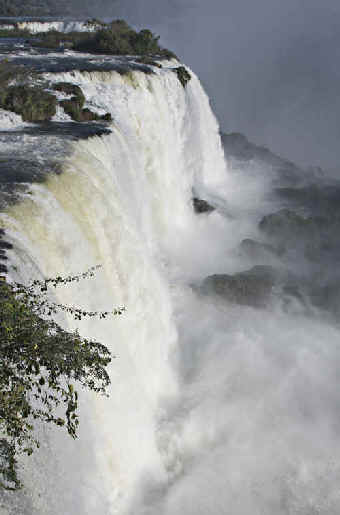
Iguacu Falls
(photo during the FONT Brazil Tour
in August 2008,
visited since then during
the FONT tour in August 2011)
Link:
Upcoming FONT Birding &
Nature Tours in Brazil
During a FONT Brazil Tour in
Mato Grosso do Sul during September 2006, an assortment of mammals seen during one night's
"safari" included:
a JAGUAR, 7 OCELOTS, a PANTANAL CAT, a MANED WOLF,
2 BRAZILIAN TAPIRS, and a number of GIANT ANTEATERS in addition to MARSH DEER,
BROCKET DEER, YELLOW ARMADILLO, TAPITI (or BRAZILIAN RABBIT), many CAPYBARAS,
CRAB-EATING FOX, CRAB-EATING RACCOON, and various BATS (along with an assortment
of nocturnal birds: OWLS & NIGHTJARS).
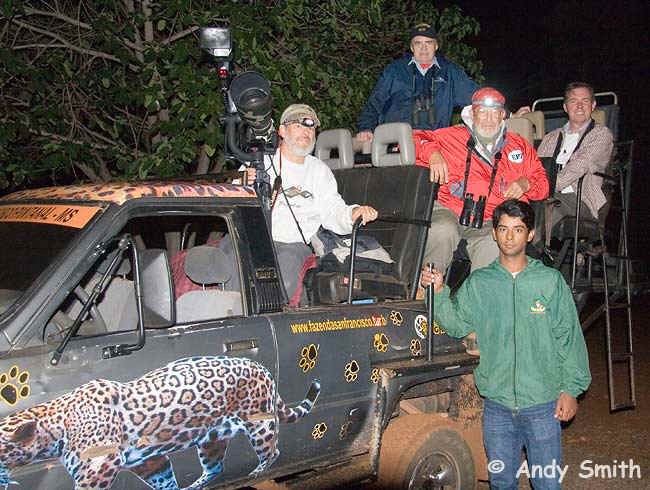
Some of the FONT group
participants
on the Brazil Tour in Mato Grosso do Sul in September 2006,
who saw the animals & birds noted above.
The tour summaries here are given with the most-recent first.
For some tours there are links below for longer narratives. Also there are links
to UPCOMING TOUR ITINERARIES, and lists (some with photos) of BIRDS, MAMMALS,
and OTHER NATURE.
Some Previous
FONT Tours in Brazil:
Iguaçu Falls & Mato Grosso do Sul - August 2011
Southeast Brazil & Minas Gerais - May 2011
Rio Grande do Sul & Mato Grosso do Sul (& Uruguay) - October 2010
Amazonia - February 2010
Minas Gerais & Rio Grande do Sul - October 2009
Southeast Brazil - August 2009
Southeast
Brazil, Iguacu Falls, & Mato Grosso - July/August 2008
Southeast
Brazil, Minas Gerais & Mato Grosso - March 2008
Southeast
Brazil, Minas Gerais & Mato Grosso - August 2007
Minas Gerais & Rio Grande do Sul - October 2006
Iguacu Falls, Mato Grosso & Minas Gerais - September 2006
Atlantic & Amazonian Forests - August/September 2005
Rio Grande do Sul, Mato Grosso & Southeast Brazil - October 2004
Iguacu Falls, Mato Grosso, & Southeast Brazil - July/August 2004
Rio Grande do Sul - August 2003
Mato Grosso - July-August 2002
Mato Grosso & Southeast Brazil - October 2001
Mato Grosso & Southeast Brazil - August-September 2001
In the FONT
Archives:
Some Photos of People, Places & More during Previous FONT tours in Brazil
In all, there have been 50 FONT birding & nature tours in Brazil.
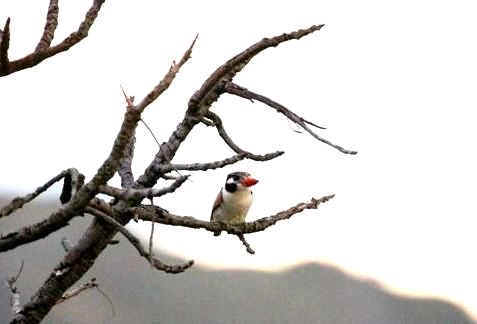
This White-eared Puffbird was photographed
during the FONT tour in Minas Gerais, Brazil in October 2009.
(photo by Marie Gardner)
![]()
Additional
Links:
A Complete List of Brazil Birds, noting those during previous FONT tours, in 4 parts:
Part #1:
Tinamous to Doves
Part
#2: Macaws to Flycatchers
Part #3: Antshrikes to
Woodcreepers
Part #4: Vireos to Grosbeaks
Birds in Mato Grosso & Mato Grosso do Sul Birds in Minas Gerais
Birds in Southeast Brazil Birds in Rio Grande do Sul
Rare Birds during FONT Tours in Brazil (with some photos)
Mammals
& Some Other Wildlife during FONT Brazil Tours (with
some photos)
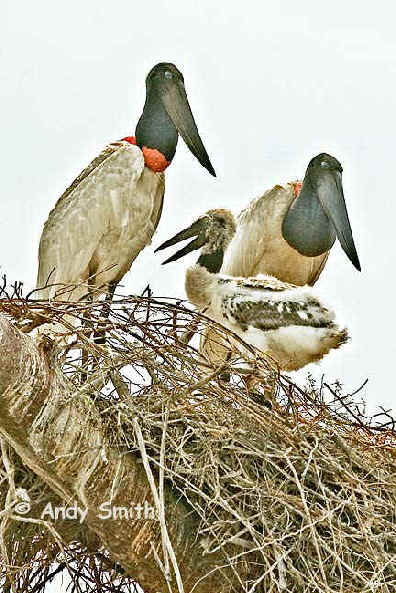
These adult Jabirus with a young
were photographed during the FONT Brazil tour
in Mato Grosso do Sul in September 2006.
More recently, parent Jabirus with their young
were seen at their nest during our tour
in Mato Grosso do Sul in August 2011.
Jabirus, often in large numbers, have been seen
during all of our tours in the Pantanal
in the Brazilian states of Mato Grosso & Mato Grosso do Sul.
![]()
BRAZIL (Iguaçu Falls & Mato Grosso do Sul) - August 2011
Our August 2011 tour in Brazil was at Iguazu
Falls and in the state of Mato Grosso do Sul,
including the Pantanal, a region known for
its wonderful wildlife, with large concentrations of birds, along with mammals
and other nature.
It was the 50th FONT tour in Brazil, since 1991.
Over the years, we've dubbed this as our "Jabiru & Jaguar
Tour". Seeing the Jabiru is
easy. But seeing the Jaguar is not.
Among the Jabirus that we saw in August 2011
were 2 parents with 2 young birds on a big nest high in a tree. After flying in,
one of the parents fed both of the two hungry youngsters.
We've seen Jaguar during 4 of our previous Brazilian tours in
Mato Grosso do Sul, once, prior to this tour, during the day,
and 3 times previously at night.
During the morning of August 10, 2011, at about 10 o'clock
we had another daytime Jaguar sighting. It was by a channel
of water, at a concrete covert, for just a short while, before disappearing into
the covert and probably out the other side.
We travel about in that area on high, open vehicles. The previous night, in such
a vehicle, we enjoyed a great look at an Ocelot, after seeing 3 Giant
Anteaters, Crab-eating Foxes, Marsh Deer, 6-banded or Yellow
Armadillos, Capybaras, and Caiman. In all, there were 18
species of mammals during the tour, not including any bats.
Also as we traveled about that night, we saw 3 species of
nightjars, and heard another.
Among the numerous birds during the tour were the Jabirus (the
largest American stork), the Hyacinth Macaw (the largest parrot in
the world), the Greater Rhea (the largest American bird), and the Toco
Toucan (the largest toucan). In all, well over 200 species of birds.
Raptors during the tour included: Aplomado Falcon, Snail Kite
(hundreds of them), Crane Hawk (seen exceptionally well), Great Black
Hawk, Savanna Hawk, Crowned Solitary Eagle, Black-chested
Buzzard-Eagle, White-tailed Hawk, and Black-collared Hawk
among others.
Parrots during the tour, in addition to the Hyacinth Macaw,
included: Blue-and-yellow Macaw, Red-and-green Macaw (a good
number enjoyed especially at a large limestone sinkhole), Golden-collared
Macaw, White-eyed Parakeet, Peach-fronted Parakeet, the Nanday,
or Black-hooded Parakeet, Reddish-bellied Parakeet, Blaze-winged
Parakeet, Monk Parakeet, Blue-winged Parrotlet, Yellow-chevroned
Parakeet, Scaly-headed Parrot, and Turquoise-fronted and Orange-winged
Amazons.
Another bird that we saw nicely during this Brazilian tour is in the photo
below. Name it rightly, and you're entitled to a 10 per cent discount on any
future FONT tour.
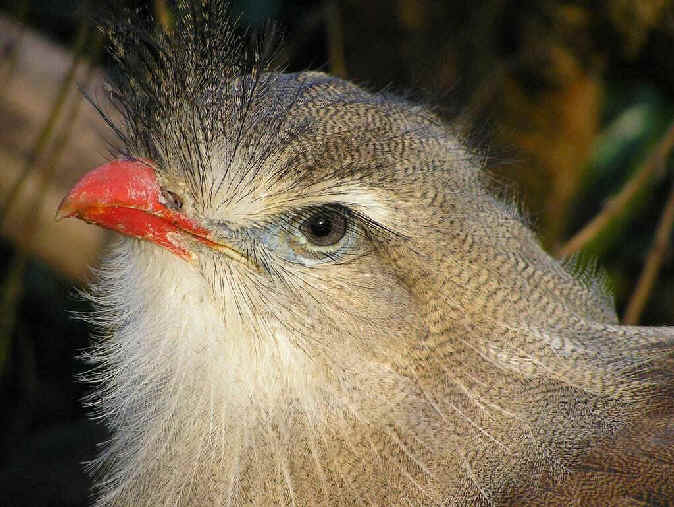
The area of Iguazu Falls was particularly good for butterflies, as it has
been during FONT tours in the past. A good number of about 3 dozen species
were seen, including various crackers, leafwings, longwings,
sisters, swallowtails, the Red Rim (Biblis hyperia), and a few species of
"88s" in the Diaethria and Callicore genera.
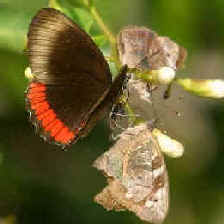
Red Rim
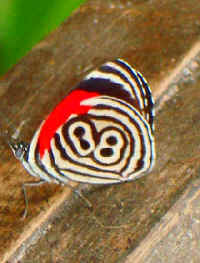
Eighty-eight Butterfly,
Diaethria clymena
Link:
List
of Birds & Other Wildlife during the FONT Brazil Tour - August 2011
![]()
BRAZIL (Southeast)
- May 2011
Our Brazil tour in May 2011 came to be as a result of the earthquake and related problems in Japan a couple months earlier. We normally have gone to Japan in May. But instead, in Brazil, we went to the southeast part of the country, including the more-inland area of Minas Gerais.
During the tour,
much of the nature we observed were birds.
And there were some nice butterflies.
But, particularly interesting were mammals, including the
largest of the monkeys in the New World, an animal known as the Muriqui.
It was the Northern Muriqui that we saw, notable not just for being the
biggest, but for being one of the
rarest mammals in the world. The Muriquis
are nearly 5 feet tall, and the total population of the species is about
500 individuals. We were fortunate to see a group of them well, in a fine
forest that has been preserved because it has been their home.
There are, in all, about a hundred species of monkeys known to be in Brazil. But among them, the Muriqui is special. It has been written that, as a conservation symbol, the Muriqui is for Brazil as the Giant Panda is for China.
Other mammals during the tour included 5 other species of monkeys: Brown Howler (the rarest of the howlers), Black Tufted Capuchin, Masked Titi, Buffy-headed Marmoset, and Buffy-tufted Marmoset. Also seen during the tour was the Maned Wolf.
Among the nearly 300 species
of birds, some of the most notable were: Black Hawk-Eagle,
Black-bellied Thorntail, Hyacinth Visoprbearer (two of the numerous
hummingbirds during the tour), Three-toed
Jacamar, Robust Woodpecker, Pin-tailed Manakin, Sharpbill, Swallow-tailed
Cotinga, Red-ruffed Fruitcrow, Streamer-tailed Tyrant, Cipo Canastero,
Black-billed Scythebill, Forbes's Blackbird (one
of the rarest birds in Brazil), Campo Troupial, and Black-masked
Finch. These were in addition to a good assortment of tanagers, toucans,
trogons, and other birds
of the Neotropics.
As was the Swallow-tailed Cotinga, among the birds just mentioned, the
male Pin-tailed Manakin was
truly a favorite, with its colorful plumage of red, black, white, and green, in
addition to its orange eyes. Other Manakins were
also seen well and enjoyed during the tour: the Blue, and the White-bearded.
Relating to the birds, the manakins alone made Brazil a nice place to be in May, but of course the tour was so much more with the Muriquis.
Links:
More about the May 2011 FONT Tour in Brazil
List of Birds & Other Wildlife during the FONT Brazil Tour - May 2011
A Gallery of Photos from the May 2011 FONT Tour in Brazil
![]()
BRAZIL - (far-southern
& the Pantanal) & uruguay
October 2010
This tour, mostly in Brazil,
was in the southernmost state in that big country - the state known as Rio
Grande do Sul.
Also visited was the southernmost of the two Brazilian states containing the Pantanal
- that state, Mato Grosso do Sul. Both of
those "southern states" ("do Sul") are bird-rich. Also
during our October 2010 tour, we spent parts
of two days in Uruguay, where we saw many
birds as well.
We've been in both of the "do Sul" states during previous FONT tours, and like to go back, because for birds there is so much to see and enjoy.
In Rio Grande do Sul, in October
2010, there were, as there have been for us in the past: large numbers of waterbirds,
notably including screamers, swans, ducks, spoonbills, limpkins, ibises,
herons, and egrets, and gulls and terns. Shorebirds
were also in good supply, as were some birds of prey. Particularly notable among
the ducks was the beautiful Ringed Teal.
Particularly notable among the birds of prey were two species of Harriers,
the Long-winged and the Cinereous. And the Snail Kites were
so abundant that we probably saw more in a few days than we probably would
otherwise in our lives.
Most of the big flocks of birds were in southern Rio Grande do Sul, but birding was also exceptional for us further north in the state, where we visited some beautiful habitat in the "high campo" with some wonderful remnants of Araucaria ("Monkey-puzzle") trees.
Not just common birds, but some rare birds were enjoyed in Rio Grande do Sul, including the very-local Long-tailed Cinclodes (described as recently as 1969), the Black-and-white Monjita, and another rarity with which it has a symbiotic relationship, the Saffron-cowled Blackbird. That blackbird was not the only special member of its tribe during our tour. We were also treated to the Scarlet-headed Blackbird, another fine bird to see.
In Mato Grosso do Sul, there were mammals, in addition to birds, including 5 Giant Anteaters (1 a mother with a baby on her back), and 2 Ocelots that we saw wonderfully well. These animals were seen after dark on excursions, during which Striped Owls and various nightjars were also seen nicely.
A complete list of the about 290 species of birds, along with more regarding our October 2010 tour in Brazil, and in Uruguay, can be found thru the links below - including why Uruguay was such a nice and interesting place to visit.
Links:
List of Birds & Other Wildlife during the FONT Brazil Tour - October 2010
A Gallery of Photos from the October 2010 FONT Tour in Brazil & Uruguay
![]()
BRAZIL
- (Amazonia)
February 2010
During this tour, in Amazonian Brazil, included a place with both Hoatzin & Harpy - Harpy Eagle, that is. It was a place in a system of Amazon waters, where we traveled mostly by boat along rivers and channels, but also where we hiked on trails in the rainforest.
Among our favorite birds were the Agami Heron and Horned Screamers, which were in addition to a good assortment of raptors, parrots and parakeets, toucans, and trogons. Small birds that were nice to see were the hummingbirds, manakins, and a tame little creature in the forest called the Dwarf Tyrant-Manakin.
But the best of our more than 200 species of birds was the Guianan Cock-of-the-Rock. Not only did we see so very well the brilliantly-colored orange males, like beacons in the forest, we enjoyed the rare sight of a female Cock-of-the-Rock sitting on its nest, on a ledge of a big rock, at a grotto by the entrance to a cave, in which, during the day, numerous bats were roosting.
Other mammals during the tour included various monkeys: the Golden-handed Tamarins, White-bearded Sakis, Brown Capuchins, and the noisy Red Howler Monkeys. In the water, we saw both Gray Dolphins and Pink River Dolphins. The Amazonian Manatee was there also.
Among other birds (too many to note here), a few, however, should be mentioned, including: the hollering of a group of Red-throated Caracaras, along with the raucous calls of macaws, that late one afternoon, made the normally loud Mealy Amazons and Red-fan Parrots seem rather quiet by comparison.
Links:
List of Birds & Other Wildlife during the FONT Brazil Tour - February 2010
![]()
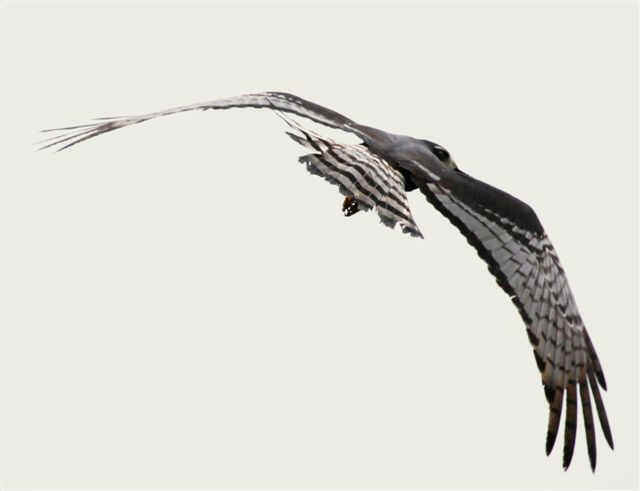
A Long-winged Harrier during
the FONT October 2009 Brazil Tour
in Rio Grande do Sul
(photo by Marie Gardner)
BRAZIL (Minas Gerais & Rio Grande do Sul)
October 2009
When it was fall to the
north of the Equator, and spring to the south, we headed to where it was
springtime with birds singing, displaying, ands in their breeding attire.
We experienced our "second spring of 2009", from October
11 to 23, as we did our 46th FONT birding & nature tour in Brazil,
and the first during which we ventured into Uruguay
(where we saw 23 species of birds on the grounds of an old fort, not too far
from the coast).
In Brazil, we were in the states of Minas
Gerais and Rio Grande do Sul. The
second of these is the southernmost Brazilian state, with the character of
nearby Argentina & Uruguay. And with birds more in tune with those
more-southerly countries, such as: Coscoroba & Black-necked Swans,
and waterbirds including 3 species of coots and ducks such
as the Red Shoveler, and landbirds such as the Warbling
Doradito and Spectacled Tyrant.
Some notable birds during our October '09
tour included the localized hummingbird known as the Hyacinth
Visorbearer, the rare flycatcher named the Black-and-white Monjita,
and the large raptor called the Black-chested Buzzard-Eagle.
We saw 8 species of terns in one area, with probably the best for us
being the Snowy-crowned, or Trudeau's, Tern. Also in that one
area, we saw 4 species of gulls, with the rarest being the Olrog's,
formerly part of the Band-tailed, Gull.
During our two-week dip into the South American spring, we enjoyed birds that
ranged from a penguin to parrots. Also, a motmot & manakins
and much more in the realm of birds (we found nearly 300 species), while
other nature during the tour included monkeys & marmosets, and
2 nights with the Maned Wolf.
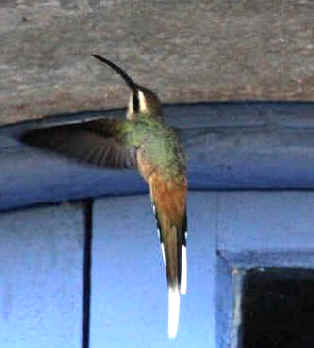
Two of the hummingbirds
during our October '09 tour in Brazil.
Above: a Planalto Hermit getting a breakfast of bugs
at a wall of an old monastery, and
Below: a Hyacinth Visorbearer with color
even on a rainy, cloudy morning.

Links:
List of Birds & Other Wildlife during the FONT Brazil Tour - October 2009
A
Gallery of Photos from the October 2009 FONT Tour in Brazil
Birds
of Minas Gerais
Birds of Rio Grande do Sul & adjacent Uruguay
Upcoming FONT Birding & Nature Tours in Brazil
![]()
BRAZIL (Southeast)
August 2009
From August
16 to 24,'09, we did our 45th FONT birding & nature tour in Brazil.
It was in the southeastern part of the country, along the seacoast and in the
mountains. Much of our birding in those areas, and in between, was in the Atlantic
Forest - an arc of native forest mostly in Brazil, with a number of
birds, animals, and plants, either endemic to southeastern Brazil or nearly so.
Birds, in those categories, that were particularly notable included tanagers
and hummingbirds.
Many of those birds and others during the tour were colorful indeed with various
hues of blues, greens, yellows, and more. In addition to about 20 species of
tanagers, other bright, colorful birds included euphonias, chlorophonia,
dacnis, and honeycreeper.
The male of one of the tanagers was mostly bright red - the Brazilian
Tanager, with the local name in Portuguese of "Sangue do Boi",
which translated means "blood of the bull".
Just as red were the Scarlet Ibises that we saw at a coastal lagoon. What
a bright flock they were as they fed in the shallow water by our boat!
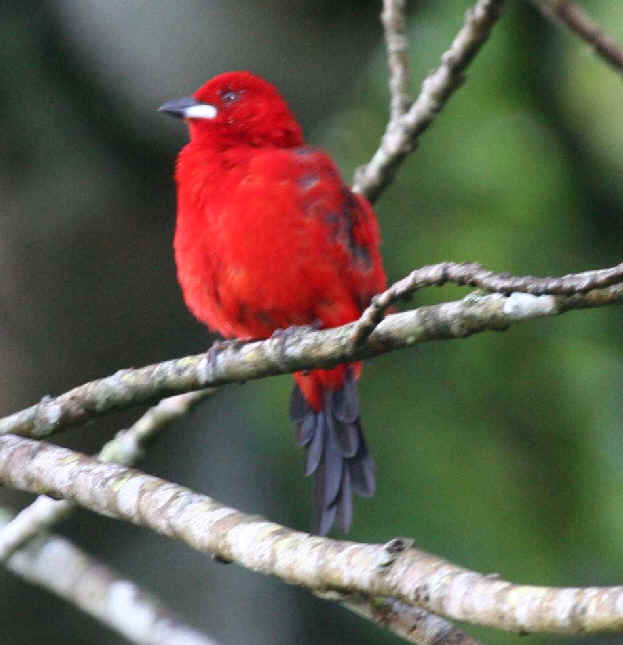
Brazilian Tanager
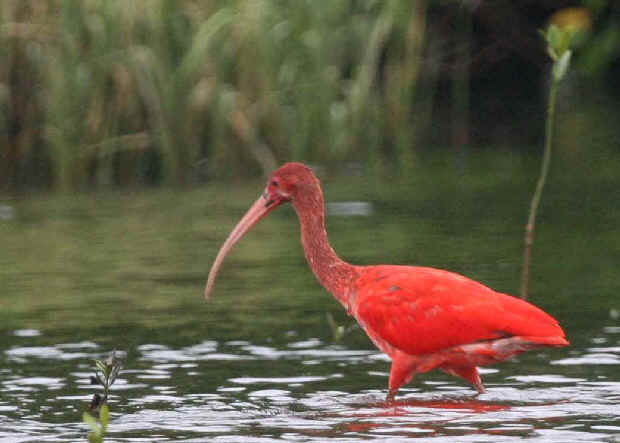
Scarlet Ibis
Also among the
colorful birds that we saw were toucans and toucanets. Even a
change of an English still relates to colors: what has been called the Red-breasted
Toucan is now known as the Green-billed Toucan. (And of course,
red & green are not its only colors.)
Other notable birds included a couple species of Herons: the Capped and
the Whistling. And a couple species of Hawks: the White-necked and
the Mantled. Both of those raptors are restricted to southeast
Brazil.
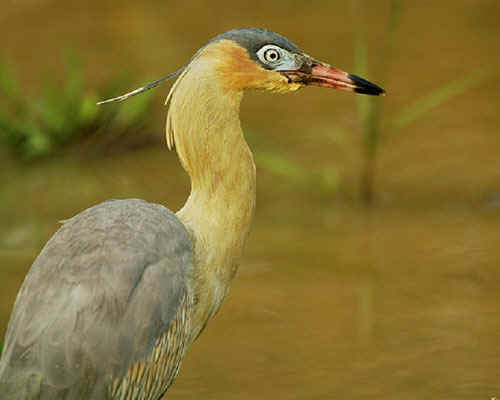
Whistling Heron
The Robust
Woodpecker that we saw at its hole in a tree by the parking lot where we
stayed is in the same genus as one formerly in North America - the Ivory-billed
Woodpecker, a bird no longer seen going in and out of any hole in a tree.
Among the woodcreepers we saw, one species was especially interesting.
Some Plain-winged Woodcreepers were traveling in the forest with a group
of monkeys - Black Tufted Capuchins. Something about those
monkeys was attractive to the woodcreepers, as they went up &
down the trees beneath them.
Two species of our flycatchers, during the tour, had long tails - one,
aptly named the Long-tailed Tyrant, that we saw one place after another,
and another that we saw only once, the Streamer-tailed Tyrant. The second
of these has always been for us a wonderful bird to see, being an attractive
bird, mostly gray with some burgundy.
But, as noted, it was the tanagers and hummingbirds that this time
for us were the avian stars of the tour. Being so close to them and their frenzy
of activity, at the places we visited with feeders, was, more than once, an
experience to be savored - and it was!
Prior to this tour, our cumulative tally of birds in Southeast
Brazil was 491 species. 5 "new ones" were added in August
'09 to that list.
Maybe the best was Green-and-rufous Kingfisher that we saw closely and
well as we were standing on a bridge. But also nice were the other 4: the Gray
Hawk, Large-billed Tern, Nacunda Nighthawk, and Sooty-fronted Spinetail.
In all, 228 species of birds were found during our Southeast
Brazil Tour in August 2009.
Links:
List of Birds & Other Wildlife during our Brazil Tour in August 2009
Birds in Southeast Brazil (with photos)
Upcoming FONT Birding & Nature Tours in Brazil
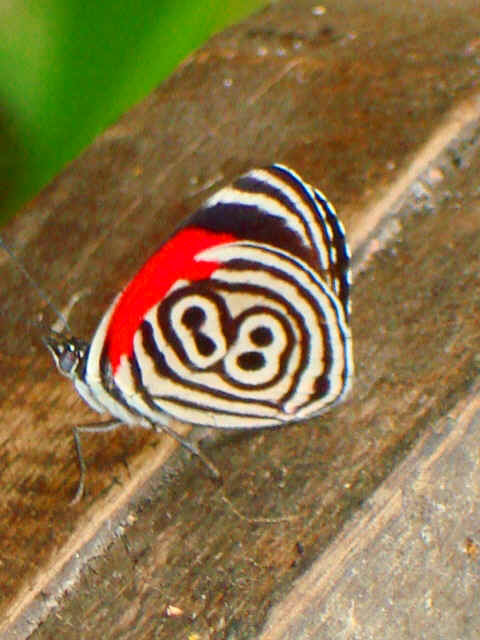
An " Eighty-eight
Butterfly", Diaethria clymena,
photographed during the August 2009 FONT tour in southeast Brazil
(this & the following 2 photos by Tom Ludes)
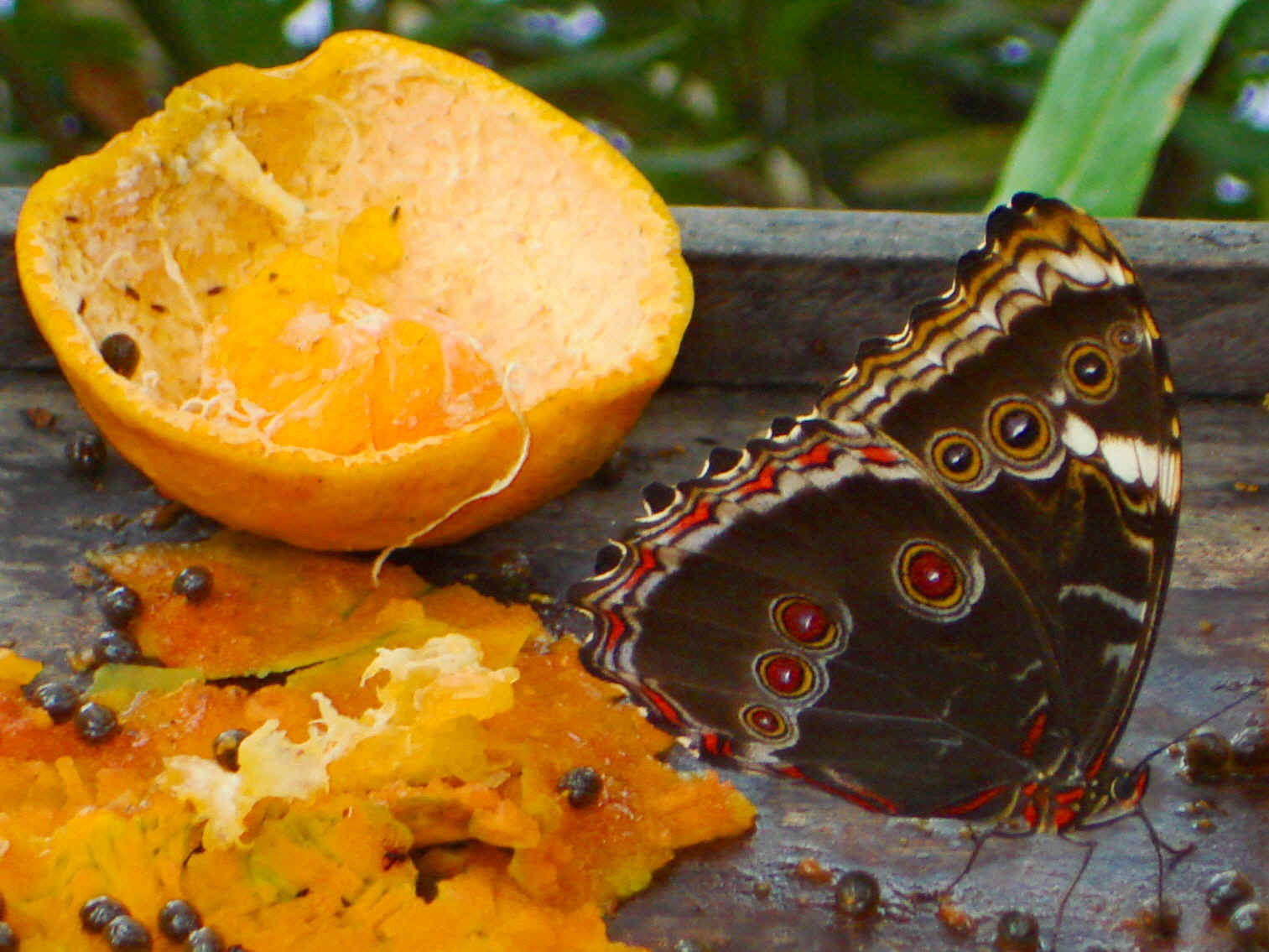
A Morpho Butterfly, having
just feasted on a mango,
also photographed in southeast Brazil during the August 2009 FONT tour.
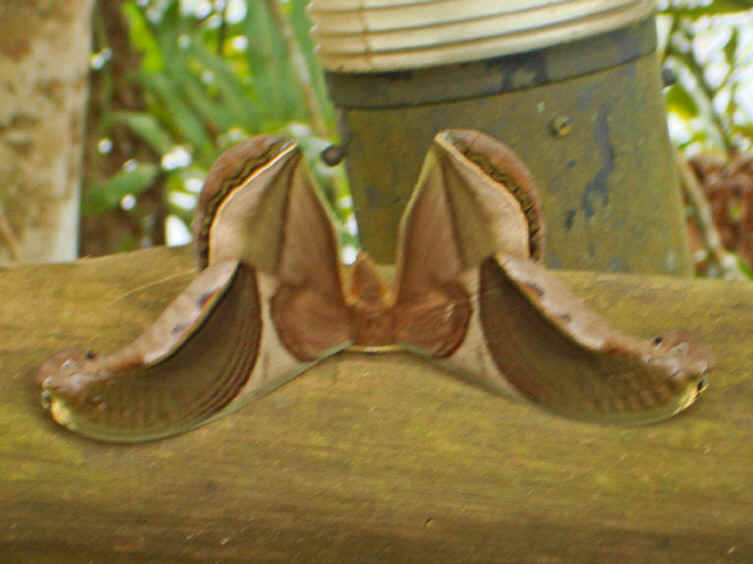
A large moth, on a wooden
fence,
during the day
This unusual creature was also photographed
during the August 2009 FONT Southeast Brazil tour.
![]()
BRAZIL (Mato Grosso do Sul & Mato Grosso) & nearby BOLIVIA
March 2009
This was the 44th
FONT birding & nature tour in Brazil,
during which there were some tremendous highlights, among them a Jaguar (1
of 3 species of wild cats during one night's excursion), a Harpy Eagle
on a nest, as many as 40 Hyacinth Macaws seen closely, and nearly 400
Jabirus at one place - on an island in a river. Over 300 of the big, tall Jabirus
were standing or walking about on short grass. The others were soaring about on
thermals in the sky above. This tour also included a sojourn into neighboring Bolivia.
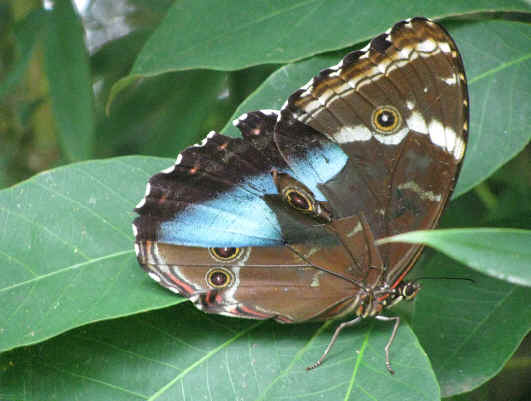
When this Morpho Butterfly
(Morpho achilles) opens its wings and flies,
it is a most brilliant blue.
This photograph was taken during the FONT birding & nature tour
in Mato Grosso, Brazil in March 2009.
(Photo by Patricia
Yoder.)
Links:
List of Birds & Other Wildlife during our Brazil Tour - March '09
Birds in Mato Grosso do Sul & Mato Grosso (with some photos)
Upcoming FONT Birding & Nature Tours in Brazil
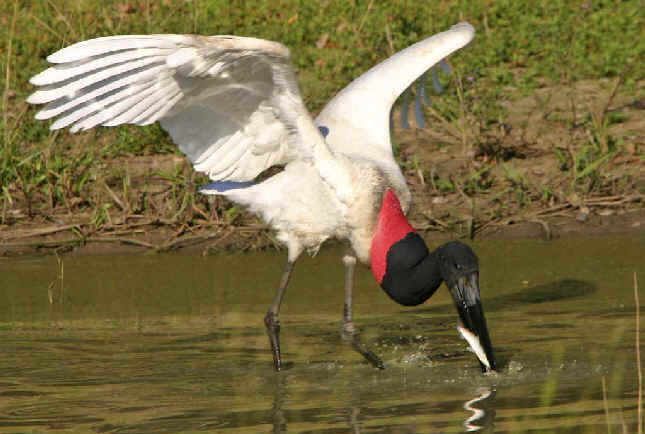
![]()
Again, during this
FONT tour in Brazil, our 43rd, a nice
assortment of birds & animals were seen. Also, particularly in the
area of Iguacu Falls, there was a tremendous variety of butterflies.
Among the mammals during the tour, highlights included: a wonderful look
at a Brazilian Tapir, as many as 7 Giant Anteaters in one day (including
a mother with a young animal on its back), a fine look at an Ocelot,
and two Giant Otters seen very well.
Nearly 300 species of birds were found.
Among the last of them, on August 18th, on the grass at the airport in Campo
Grande, there was, in addition to Red-winged Tinamous, an Upland
Sandpiper, having just flown in from North America.
On a nearby wire, that day, there were 3 Purple Martins, also having just
come from North America.
Links:
List of Birds & Other Wildlife during our Brazil Tour - July/August '08
Birds in Mato Grosso do Sul (with photos)
Birds in Southeast Brazil (with photos)
Butterflies of Brazil & Argentina, including those at Iguazu Falls (with photos)
Upcoming FONT Birding & Nature Tours in Brazil
![]()
BRAZIL
(Southeast Brazil, Minas Gerais, & Mato Grosso)
March 2008
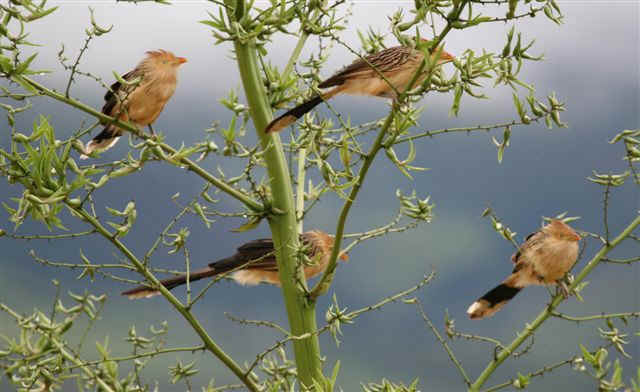
The above photo of
odd-looking Guira Cuckoos
was taken during the FONT tour in Brazil in March 2008.
Subsequently, it was chosen by National Geographic
to be in its web-site.
(Above photo by Marie Gardner)
This & the longer narrative from the link below were written by Armas Hill, leader of
the tour:
During this, the
42nd FONT birding & nature tour in Brazil,
again, as during our tours there in the past, wonderful birds and animals were
seen.
Such tours in Brazil usually bring to mind notable birds as the Hyacinth
Macaw and the Jabiru. These we saw, but also there were so many other
birds, and among them highlights including the very rare Brazilian Merganser,
a pair of Crowned Solitary Eagles, the Cock-tailed Tyrant, and the
tiny & very localized Buff-throated Purpletuft.
This was the 6th FONT tour with the Brazilian Merganser, one of the
rarest birds in the world. (That's 6 times out of 7 tries for that bird.)
Among the mammals during the tour, an Ocelot was seen so nicely as
it walked backed & forth on a dirt road ahead of us, and a Maned
Three-toed Sloth was seen, in an area where not expected - in lowland
Atlantic Forest near the Brazilian Seacoast. But see it we did, and so very
well, as it so very slowly, made its way down a tree in front of us.
Other animals that we saw included: Six-banded Armadillo, Tapiti (or
Forest Rabbit), Paca, Capybara, the cat known as the Jaguarundi,
Crab-eating and Hoary Foxes, Crab-eating Raccoon, Neotropical
River Otter, and 3 species of deer.
Back again to the Maned Three-toed Sloth, it's a rare and endangered
mammal, and was a "new one" for FONT in Brazil, being the 69th species
of mammal for us there (excluding bats - and we saw a few of
them too).
Also during our March '08 Brazil tour, a nice assortment of butterflies was
seen.
A listing of the birds (with a number of photographs of them, and the mammals
& butterflies) is with the longer tour narrative reached from the above
link.
Links:
More about the FONT Brazil Tour in March 2008
List of Birds during our Brazil Tour - March 2008
A Photographic Sampling of Nature & Scenery from the FONT March 2008 Brazil Tour
Birds in Minas Gerais (with photos)
Birds in Mato Grosso do Sul (with photos)
Birds in Southeast Brazil (with photos)
Upcoming FONT Birding & Nature Tours in Brazil
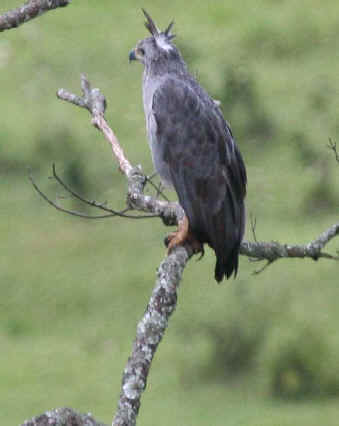
The Crowned Solitary
Eagle,
seen during our March 2008 Brazil Tour,
the "top bird" of the tour.
One of a pair of eagles we saw together.
(photo by Marie Gardner)

The FONT Brazil March '08 Tour
Group
having dinner one evening during the tour
![]()
BRAZIL
(Southeast Brazil, Minas Gerais, & Mato Grosso)
August 2007
The following written by Armas Hill, leader of the tour:
We've called this
our tour for "Jabiru & Jaguar".
And, again this year, as last year, it was. We saw both.
In 2006, during our tour in the Brazilian region of Mato
Grosso do Sul, we saw a Jaguar at night, first as it was still
and then as it walked across a field.
During this tour, in 2007, our sighting of the magnificent animal was during the
day. From an open vehicle, a few feet above the ground, we saw it, closely, not
more than a few yards away. The spots on its back were visible in the tall
grass, and a few times the animal raised its large head to look at us. What a
sight! What an experience!
The Jabirus that day (also large) were wonderful to see as well.
We saw a number of them, usually standing or walking on the ground or at pools
of water. But a particularly nice sighting was of an adult Jabiru and 2
smaller ones an a nest high up in a tree.
One time, as we were observing a pair of Jabirus feeding in a pool, a
herd of more than a dozen White-lipped Peccaries walked by between us and
the birds. Among the peccaries, there were some very small ones, recently
born.
The Jabiru was certainly not the only large bird during the tour.
There were also Greater Rheas and Hyacinth Macaws. The latter were
very exciting to see, one morning, as one pair, then another, flew across
against the blue sky above us!
In all, 305 species of birds were found during this 10-day tour, the 41st FONT
birding & nature tour in Brazil.
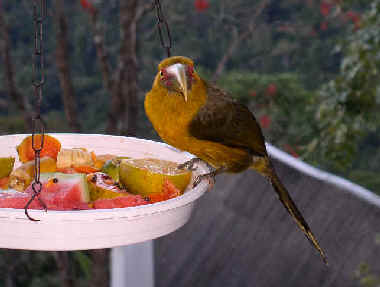
A Saffron Toucanet
photographed as it feasted
during the FONT August '07 Brazil tour
(photo by Dan Coleman)

FONT tour participants
birding along the side of a quiet road
in the state of Minas Gerais
during our August 2007 tour in Brazil.
Links:
More
about the FONT Brazil Tour in August 2007
Birds & Other Wildlife during our Brazil Tour - August '07
Upcoming FONT Birding & Nature Tours in Brazil
![]()
BRAZIL (Minas Gerais & Rio Grande do Sul)
October 2006
The following written by Armas Hill, leader of
the tour:
This was the 40th FONT birding
& nature tour in Brazil, during which we visited the state of Minas Gerais,
where the Swallow-tailed Cotinga was among the birds and Giant
Anteater & Maned Wolf were among the animals seen.
The second part of the tour was in the southernmost Brazilian state of Rio
Grande do Sul, one of our favorite birding locales, as it is one of the birdiest
places that we visit. Some species we've seen there in the thousands, including
ibises, whistling-ducks and other waterfowl, and gulls and
more.
Species in southern Rio Grande do Sul, include, on the whole, those common in
nearby Uruguay & Argentina, including 2 types of swans, various
ducks (with the Ringed Teal being common), 3
types of coots, and the Giant Wood-Rail.
In that area during one day, we saw 7 species of Terns: Snowy-crowned,
South American, Common, Antarctic, Large-billed, Yellow-billed, Royal, &
Cayenne.
Tyrants in the region included: Spectacled, White-headed Marsh,
Yellow-browed, Cattle, Blue-billed Black, and Crested Black.
Blackbirds included: Chestnut-capped, Yellow-winged, White-browed,
Scarlet-headed (a beauty!), and Saffron-cowled (a rarity!),
in addition to 3 species of Cowbirds and 2 species of Marshbirds.
The Saffron-cowled Blackbird was one of the 3 notable rarities during the
tour. The others were the Black-and-White Monjita and the Canebrake
Groundcreeper.
In all, over 300 species of birds were seen, including some, as noted, in
spectacular numbers.
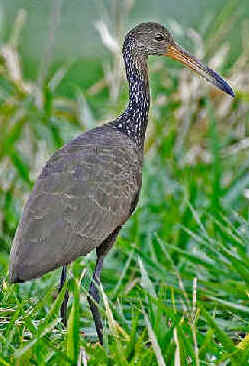
The Limpkin,
one of the birds occurring in large numbers
in Rio Grande do Sul, Brazil
Links:
More about the FONT Brazil Tour in October 2006
Birds & Other Wildlife during our Brazil Tour - October '06
Birds in Rio Grande do Sul, in far-southern Brazil (with photos)
Birds
in Minas Gerais
(with
photos)
Upcoming
FONT Birding & Nature Tours in Brazil
![]()
BRAZIL
(Iguacu Falls, Mato Grosso, & Minas Gerais)
September 2006
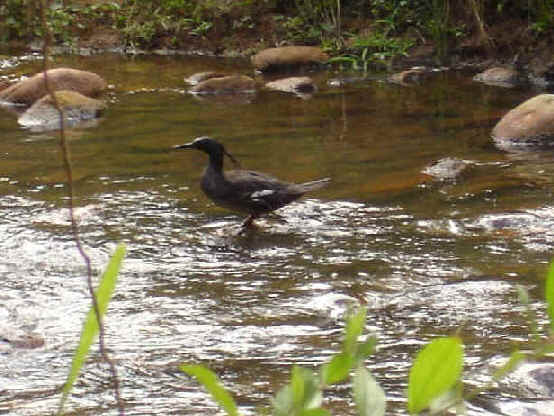
The very rare Brazilian Merganser in Minas
Gerais, 2006.
A pair was seen during the FONT September '06 tour.
(Photo courtesy of Renilda Dupin)
The following written by Armas Hill, leader of
the tour:
This tour, our 39th in Brazil,
was dubbed the "J & J Tour",
for the Jabiru & the Jaguar. And
appropriately so, as we saw both. The Jabiru is easy; the Jaguar
is more of a challenge. During open-vehicle excursions in the southern Pantanal,
on two consecutive nights, the Jaguar was one of a number of animals that
we saw. Others were: 7 Ocelots, a Pampas Cat, a Maned Wolf,
2 Brazilian Tapirs, 3 Giant Anteaters, both Crab-eating Foxes
& Crab-eating Raccoons, a dozen or so Marsh Deer, the Tapiti
(or Brazilian Rabbit), and many Capybaras.
Also
during those nocturnal jaunts, both Striped & Barn Owls were
nicely seen, as were Nightjars of various species including the Scissor-tailed.
Also heard those nights were Rufous Nightjar and the Gray (formerly
Common) Potoo.
Other animals during the tour in the Pantanal, in the daytime, included Giant
Otters, and Brocket Deer.
Many birds were seen in addition to the Jabiru.
Notable among them was the Hyacinth Macaw. But the most notable of the
birds of the tour was during our time in the region of Minas Gerais - the
extremely rare Brazilian Merganser. We enjoyed a pair of these birds in
our scope as they rested on and by streamside rocks.
During this tour, in the Brazilian areas of Iguazu Falls, Mato Grosso do Sul,
and Minas Gerais, with visits to parts of Paraguay and Bolivia, about 400
species of birds were found.
The birds voted by the participants, following the tour, as the "Top
Birds" were:
1 - Brazilian Merganser (p)
2 - Streamer-tailed Tyrant
3 - Red-legged Seriema
4 - Black-breasted Plovercrest
5 - Pale-crested Woodpecker (p)
6 - Red-billed Scythebill (p)
7 - Spotted Nothura
8 - Striped Owl (p)
9 - Scissor-tailed Nightjar (p)
10 - Toco Toucan
11 - Swallow-tailed Hummingbird
12 - Blond-crested Woodpecker
Links:
More about the FONT Brazil Tour in September 2006
Birds & Other Wildlife during our Brazil Tour - Sept '06
Photos of Birds & Animals from our Sept '06 Brazil Tour
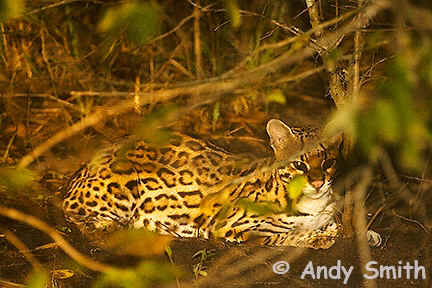
One of the 7 Ocelots seen
during the FONT Sept '06 Brazil Tour.
![]()
BRAZIL (the Atlantic & Amazonian Forests)
August/September
2005
The following written by Armas Hill, leader of the
tour:
During this, our 38th tour in Brazil, areas of the Atlantic Forest of SE Brazil and Amazonian Forest near Manaus were included. In the latter, we made 3 visits atop tall towers in the forest to view birds of the canopy. There were boat-trips in both the light water of the Amazon channels and in those with dark water of the Rio Negro. Avian highlights of this tour included fine looks at Guianian Cock-of-the Rocks, the Crimson Topaz hummingbird, and the Pompadour Cotinga. During the combination of this and our August 05 tour in Mato Grosso & in SE Brazil, over 500 species of birds were found, along with interesting mammals and other nature too.
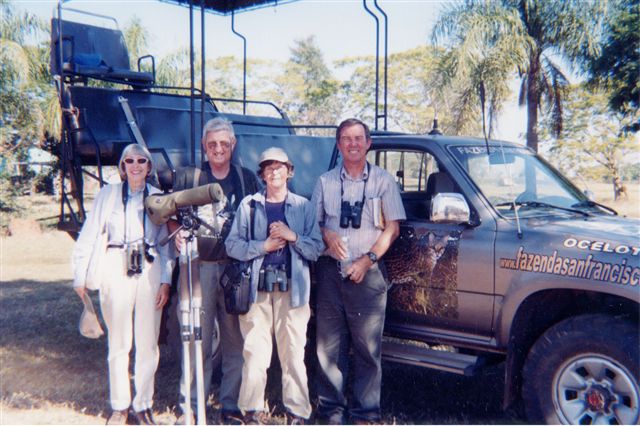
Above: Some of our
August 05 Brazil Tour Group
in the Pantanal in front of the vehicle from which the previous night
we had a wonderful look at an Ocelot.
Below: A Capybara in the Pantanal during the day.
Link:
Birds
& Other Wildlife during our Brazil Tours - Aug/Sept '05
![]()
BRAZIL
(the
far-south: Rio Grande do Sul, and Mato Grosso, and the southeast)
October
2004
The following account written by Armas
Hill, leader of the tour.
During our October 2004 FONT birding tour in the far-southern Brazilian state of Rio Grande do Sul, some oceanic birds were seen on the South Atlantic Ocean. However, they were not seen offshore, but from shore. And from where we could walk, that's right, walk, from shore.
There's a long jetty, of rocks and concrete, that extends over 2 kilometers into the ocean, from a beach by an inlet. SOUTHERN SEA-LIONS and BOTTLE-NOSED DOLPHINS, feeding by the jetty, indicated that in the waters there were fish. Fishermen camped on the jetty indicated that as well. And so there would also be SEABIRDS.
The most common of which at the end of
the jetty were WILSON'S STORM-PETRELS, with their dangling feet behind them as
they fed on the smooth water surface. There were about 50 of them, where GREAT
GREBES were diving for fish beneath the surface.
And of course, there were GULLS, mostly KELP.
But, as we later drove along the beach, south from the jetty, there were yet
more birds, among them TERNS (7 species SOUTH AMERICAN, COMMON, SNOWY-CROWNED,
CAYENNE, ROYAL, YELLOW-BILLED, and ANTARCTIC).
And PARASITIC JAEGERS were sitting on the beach, both the dark and light morphs.
They stayed, tamely, as we watched them from the windows of our vehicle.
We drove further. We almost could have driven indefinitely, but we stopped where
just offshore, beyond the surf, there were fishing boats, and with them, soaring
BLACK-BROWED ALBATROSSES and WHITE-CHINNED PETRELS.
Certainly, not a bad oceanic day, without
ever having been on a boat!
Link:
Birds & Other Wildlife during our Brazil
Tour - Oct '04
top of page
![]()
BRAZIL (Iguacu
Falls, Mato Grosso, & the Southeast)
July/August 2004
(with
some notes regarding our subsequent tour in October '04)
The following account written by Armas
Hill, leader of the tour.
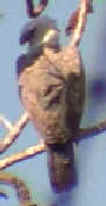
This July/August tour was the first
of two for us in Brazil in 2004, during which we saw the Harpy Eagle.
Actually, there was one particular young bird that we were to see two times in
the same area of a nest in a southern Mato Grosso
forest. The second tour was two months later, in October.
It was quite interesting to see how the young bird, that was already large in
August, had increased in size by October.
In August, when it stood on a branch up in a huge tree, the immature Harpy appeared
to dwarf a nearby Gray-lined Hawk standing on a branch of another tree.
The young Harpy Eagle, stayed in just about the same area, in a large tree or
two, during both of our visits, in August & October. During the August tour,
we also saw the adult female Harpy, in the top of another huge tree in nearby
forest.
During both tours, in August and in October, the young bird begged loudly for
food. We never saw the adult come to the nest, but we knew it recently had, as
during the second day of our stay in the area, the youngster was observed
tearing apart its meal and eating it. When the begged, it gave a single call,
repeatedly, that could be heard far away from the bird. At times, the bird gave
consecutively as many as 25 to 30 calls. In a telescope (or even binoculars),
during each call, the red coloration inside its mouth could be seen. Each time
it called, the big young bird elastically moved its wings, up and down. Both of
our experiences with the Harpy Eagle (in August & in October) were
tremendous.
As noted, the Harpy Eagle, when still young, was already a very big bird.
The female of the species is the largest of the world's raptors. Overall, the
species is the most powerful of birds. A massive Harpy Eagle can weigh nearly 20
pounds (about twice the weight of the Bald Eagle of North America). Prey
includes monkeys, sloths, and porcupines. For those creatures in particular, but
also in a general sense, the Harpy Eagle is undoubtedly the world's most
formidable bird.
The Harpy Eagle is seldom seen soaring high above the treetops in the
forest. It habitually enters is nest, high in the tallest trees, from below. The
short, broad wings of the bird enables almost vertical movement through the
trees. The nest is a platform of large sticks, initially about 4 feet
across and 2 feet thick. More is added to it in later years, getting it up 5
feet in diameter and 4 feet thick.
A juvenile, when between 8 and 10 months of age, enter its first immature molt,
and has a well-developed power of flight. However, at that age, (as the was bird
we saw in October), it is still entirely dependent on adults for food. Such a
young bird generally stays in its nesting territory, within a radius of 100
yards of the nest tree. That large tree is used by the youngster for its
perching.
About a half-hour after sunrise, a juvenile bird begins calling. If especially
hungry, it flaps its wings, as it calls, perhaps "signaling" to its
parent. (In the first paragraph here, this repetitive calling & signaling
was referred to.) Food is not brought by the adult every day. Sometimes, it
comes as infrequently as once in 5 days. Later, as the parent feeds the young
bird even less, the young Harpy Eagle's food-begging call changes to a
combination of a "scream" and a pathetic "whine". The long
period of dependence of a juvenile on its parents suggest that adults nest not
annually but in a cycle of a year and a half to two years. A new bird when grown
must find its own territory. As noted above, a pair of Harpy Eagles can use a
nest repeatedly.
We look forward to having a "Harpy Experience", as we did twice
in '04, repeatedly as well.
Link:
Birds & Other Wildlife during our Brazil
Tour - Jul/Aug '04
![]()
BRAZIL
(Mato Grosso)
August 2003
with a Plethora of Piscivorous Birds
The following account written by Armas
Hill, leader of the tour.
In the Brazilian state of Mato Grosso, the region known as the Pantanal is one of the most renowned places for birding in the world (and for good reason). It is "birdy".
The region normally has pronounced wet and dry seasons. Our birding tour there in August is during the dry time. Waterbirds are concentrated at that time in the reduced areas of water. There are spectacular masses of egrets and herons of various kinds, storks (including Wood Stork and Jabiru), Spoonbills, Cormorants, and more.
Many of these birds are piscivorous, that is "fish-eating". In the ponds, and the rivers, there must be very large numbers of fish, as fish-eating birds abound. Anhingas, cormorants, herons, and egrets, terns and kingfishers at some places in tremendous numbers. And there are other creatures in the waters, ranging from caimans to capybaras.
But it's birdlife that's truly a spectacle in the Pantanal. During each day of our tour there, over a hundred species were seen.
In that area of avian superlatives, there are a number of birds that are big! Some are the largest of their kind.
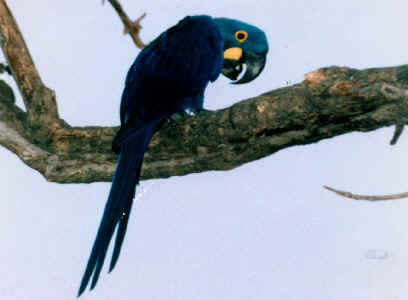
Hyacinth Macaw
The Hyacinth Macaw is the
largest of the macaws.
The Toco Toucan is the largest of its tribe.
Another bird seen during the tour, the Greater Rhea, is the largest of
all American birds.
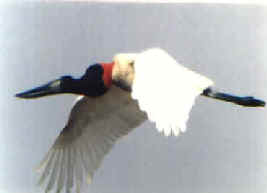
Jabiru
The huge stork, the
Jabiru, is also among the biggest. Jabirus with young were on their
nests (also big). Also with young on their nests were Plumbeous Ibis,
one of a few ibis species in the area. Making a clamor in those bulky stick
nests of the ibises and Jabirus, were groups of Monk Parakeets (noisy
little neighbors).
In a riverside forest, large Bare-faced Curassows were seen walking
about.
And yet another large bird, to add to our cast of avian characters of the
Pantanal, was one that when we saw it, during the day, sat still in a tree,
silently. It was one of the best finds of the tour, a Great Potoo. Of
course, we had looked forward to seeing birds such as the Hyacinth Macaw
and the Jabiru, but we expected to see them. The Great Potoo, as
we saw it, was unexpected.
Outside the Pantanal, during our August 2003 Mato Grosso, Brasil Tour, we enjoyed good looks at Red-legged Seriemas, in the dry habitat known as "cerrado", where also we saw a nice grouping of White Woodpeckers, and some notable Tanagers White-banded (it looks rather like a Loggerhead Shrike), White-rumped (they duet), Black-faced, and Cinnamon.
But the highlight in that dry area was one particular tree, filled with purple flowers and hummingbirds. Among the dozens of hummingbirds, there were particularly attractive Horned Sungems and Amethyst Woodstars. The males of both have long tails. The female sungem does as well.
Further north, in an Amazonian
forest of Mato Grosso, a highlight indeed was a fine look at a Paradise
Tanager, a beautiful bird filled with colors. Our
August 2003 Mato Grosso Tour in Brazil was filled with birds!
To
Top of Page
![]()
BRAZIL
(Rio
Grande do Sul)
July/August 2003
The following account written by Armas Hill,
leader of the tour.
Rio
Grande do Sul is the southernmost
state in the large South American country of Brazil.
It borders on Uruguay, and is as far south as parts of Argentina and Chile.
And it is a wonderful place for birding, with nearly 600 species recorded in the
Brazilian state that´s about the same size as the American state of Colorado.
Nearly 300 of those species reach an edge of their range in Rio Grande do Sul, such as northern species at their southern limit, and southern species at their northern limit. Migration and seasonality also have much to do with the birdlife of Rio Grande do Sul.
Our tour in that state, in late July and early August 2003, was during the winter there. At about 30 degrees south latitude, it's not a place with a cold winter. But penguins can occur along the coast.
We rode along the beach, a
portion of the state's long coastline. The pristine beach continued on for many
miles. People were few, mostly fishermen. However, birds were many, along the
surf, and on the sand, with shorebirds including oystercatchers,
stilts, plovers (mostly Collared), egrets (Snowy), gulls
and terns. Among 5 species of Terns, the most common for us was a
nicety known as the Snowy-crowned. Among the Gulls, there was the
attractive Gray-headed.
We didn't see any penguins during our time by the sea, but we did have the good
fortune of seeing rather closely, just beyond the surf, a large bird gliding in
an up-and-down flight, a Black-browed Albatross.
Later that day, away from the ocean, in some small trees by a pond, we saw a Bananaquit. Only mentioned, as how often is it that an albatross and a bananaquit are seen during the same day. Such is birding in Rio Grande do Sul.
Returning to the seashore, by the dunes next to the beach, at a small marsh, one of the nice sights of the tour was of Scarlet-headed Blackbirds perched in a bare tree. In the marsh itself, there was a Warbling Doradito, a skulker. Not far away, a nearly all-white bird, a White Monjita, was much more obvious. (Monjitas are in the flycatcher family.)
In another part of Rio Grande do Sul, quite different, at a higher elevation, in an area of open grasslands, we saw another Monjita, the Black-and-White. And following a pair of them, there was another member of the blackbird family, one of the rarest of birds (some say headed toward extinction), the Saffron-cowled Blackbird. We saw a pair of them. Quite interesting behavior, not understood, is that Saffron-cowled Blackbirds (the few there now are) follow the Black-and-white Monjita. The monjita perches on reeds and bushes. The blackbirds walk about, feeding on the ground beneath them. Both the monjita and the blackbird are considered threatened. The blackbird, as noted, severely so.
A feature of the Rio Grande do
Sul landscape, that's distinctive, and rather unusual, are the groves and
forests of Araucaria trees. Araucarias are
conifers. They are flat-topped, with long horizontal, upturned branches. Some
species of birds are associated with these odd-looking trees, including the Araucaria
Tit-Spinetail, the Azure Jay, and 2 species of parrots, both Amazons,
the Vinaceous-breasted and the Red-spectacled. All of these are
considered threatened, or nearly so, as the araucaria forests have been reduced.
The two parrots are particularly threatened, dependent now on isolated
patches of the particular tree. We enjoyed seeing all of the 4 species just
mentioned. The Araucaria Tit-Spinetail was voted the "Top Bird"
at the tour's end. We had some particularly good looks at this crested bird,
with a long tail. It was one of a number of "nice birds" during the
tour.
To
Top of Page
![]()
BRAZIL (Minas Gerais)
August 2002
The following account written by Armas Hill, leader of the tour.
This was the third in our set of 3 Brazilian birding tours during the summer of '02. Each of the 3 was a week. During the combined 3-week set a total of 500 species of birds were found.
During our week in the state of Brazil known as Minas Gerais, among the birds were some fine rarities and specialties.
Among them,
was the very rare Brazilian Merganser. At a place called Canastra, a pair
was seen well. The birds flew in, close by us, to a small river. Once on the
water, they swan for a while, as they began to feed on small fish. With the sun
behind us, and the birds in close, we were treated to wonderful looks, both by
telescope and in binoculars. When the pair flew in, our eyes beheld a thrilling
sight. They came rather unexpectedly. The whole experience was truly superb, as
the Brazilian Merganser is not only the rarest of ducks in the Americas, it is
one of the rarest of world’s birds. Recent estimates have put the population
at only about a hundred pairs. And some say that’s even too high a number.
With large territories, and favoring remote areas, it is not an easy bird to
see.
The
species, however, has also been seen during 2 previous FONT tours: in March
1997, and in October 1998. During both times previously, it was also seen in the
Canastra area of western Minas Gerais. Now, with our latest sighting, the bird
has been found during a FONT Brazilian birding tour during the month of August.
The Brazilian Merganser’s range has included southeast
Brazil, northeast Argentina, and adjacent Paraguay. It’s probably now extinct
in Paraguay, and may be in Argentina (where the population has been critically
small). Actually, in the mid-20th Century, the species was thought to
be extinct altogether. It was re-found in 1948. Now, just over 50 years later,
the bird is still "too close" to extinction.
Another
rarity, and a local speciality, seen during our August 2002 tour in the
Brazilian state of Minas Gerais, was the Cipo Canastero. It’s a bird
that became known to science only as recently as 1985. When the species was
discovered, it was a surprise as all other canasteros occur much further
to the west in South America, and mostly in Andean habitats.
We’ve
had Cipo Canastero sightings have been during all of our tours to where the
species was initially found. Those tours, over the years, have been in March,
August, and October.
A third
rarity, during our August 2002 Brazil tour in Minas Gerais was the Three-toed
Jacamar (having 3 toes instead of 4). This Brazilian endemic has, during
recent years, undergone a major decline in numbers, and a contraction of its
range.
Other highlights of the Minas Gerais portion of our Brazil
'02 summer tours included a beautiful Aplomado Falcon perched in the
late-afternoon sunlight, a fine assortment of antbirds in the forest, by
day, at Caraca, where a Maned Wolf was seen after dark, and a wonderful
close-up encounter with Swallow-tailed Cotingas and numerous other birds,
notably hummingbirds, near the attractive historic city of Ouro Preto.
To
Top of Page
![]()
The following account written by Armas Hill, leader of the tour.
A few miles to the north, in
the region of Mato Grosso known as the "Chapada", the cast of avian
characters is quite different. On the higher plateau, there, species occur
that favor the dry habitat known as the "cerrado". And forests have
a mixed recipe of some Amazonian and non-Amazonian species.
In the "cerrado", we had a tremendous look at a Collared
Crescent-chest (an attractive tapaculo). And we also had some good
encounters with the Checkered Woodpecker, Rusty-backed Antwren, Blue-tufted
Starthroat, Curl-crested Jay and Coal-crested Finch, and both the White-rumped
and White-banded Tanagers (the latter incidentally looks alot like
a North American Loggerhead Shrike). Large birds were still to be seen: there
were pairs of Red-and-green Macaws flying about, calling raucously as
they went. We enjoyed, at the end of an afternoon, by a cliff above a
beautiful waterfall, a particularly-pleasing encounter, eye-to-eye with a pair
of Blue-winged Macaws.
In the forest, our birds included Tataupa Tinamou, Pheasant Cuckoo,
White-wedged Piculet, Green-backed Becard, Eastern Sirystes, White-backed
Fire-eye, and Lettered Aracari.
Further north, the birds
became more "Amazonian" in an area that we've liked to visit during
our previous FONT birding tours in Mato Grosso: the Jardim da
Amazonia (or the "Garden of the Amazon"). During the past 3
years (since it opened), 6 FONT tours have visited the place. A
fine list of birds has cumulatively been seen. During this tour, among the
birds there that we particularly enjoyed seeing were Black-girdled Barbets,
and Paradise Tanagers, the latter in a flock with other tanagers and
allies indigenous to the Amazon basin. Related to tanagers, and also colorful
were both Yellow-bellied and Black-faced Dacnis.
During an afternoon boat-ride along the pristine Rio Claro, at the day's end,
on a tree limb above the river's edge, there was a Great Potoo. A great
sight! And those dark eyes of the potoo looked at us too. It was one of many
fine moments during our 2002 tour in Mato Grosso, Brazil.
![]()
The following account written by Armas Hill, the leader of
the tour.
![]()
BRAZIL
(Mato Grosso & the Southeast)
August/September 2001
This account written by Armas Hill, the leader of the
tour.
.
In August, we had some stupendous birding during our tour in Brazil - our 25th birding tour in that ornithologically-intriguing country.
In southeastern Brazil, the most special of the birds included these "goodies" both Swallow-tailed Cotinga and Black-and-gold Cotinga, Spotted Bamboowren, Vinaceous-breasted Parrot, Araucaria Tit-Spinetail, Long-trained Nightjar, Buff-throated Purpletuft, and a bird that has been called the Shrike-like Cotinga. That name, apparently, was too easy to say - so the species is now called the Brazilian Laniisoma (and, no, that's not Portuguese!)
During our tour in Mato Grosso, including the bird-rich wetlands of the Pantanal and the dry habitat of the Cerrado, many birds were seen as always. And always great to see are the large Hyacinth Macaws and Jabirus. And the Sungrebe and Sunbitterns, the Red-billed Scythebill, Great Rufous Woodcreeper, Helmeted Manakin, and Scissor-tailed Nightjar. The list can go on and on.
From a lookout where we had hoped to see a Harpy Eagle, we saw instead a fly-by Orange-breasted Falcon.
Then, we went to one of our favorite places, the Jardin da Amazonia or the "Garden of the Amazon". We had good looks at many "Amazonian species", some of them even with that adjective the Amazonian Umbrellabird, Amazonian Royal-Flycatcher, and Amazonian Pygmy-Owl (yes, we SAW the owl, sitting in a tree by day. On the ground, we saw Razor-billed Curassow. At an ant swarm, among the best of the antbirds was the Black-spotted Bare-eye. Blue Ground-Doves were common. Red-headed Manakins were enjoyed. In the treetops, sat both Spangled and Pompadour Cotingas. Among the tanagers, one called "Paradise" in a place that is.
But, then, somehow, it got even better. We went to an area of Amazonian forest, 2 hours to the north, where no one have ever birded in the past. It was a wild, very wild area. On the dirt roads, there were many tracks of wild cats, many of the Jaguar. On a road, a Tapir was seen. Trumpeters cross the road too. Among the birds, there were others that were tremendous the Pavonine Quetzal, both male and female Pompadour Cotingas, a White-browed Purpletuft (a small cotinga) feeding young, and a striking Black-necked Red-Cotinga!! Yes, it was a tour for cotingas! And much more.
![]()
BRAZIL (Amazonian & Atlantic Forests)
October 2001
The following account written by Armas Hill, the leader
of the tour.
Our October 2001 Brazilian
Birding Tour included both Amazonian Forest in the state of Mato Grosso and
Atlantic Forest in southeastern Brazil.
In the latter, in the Paranapiacaba Mountains, southwest of Sao Paulo, it was
spring. In the treetops, Bare-throated Bellbirds were proclaiming their
territories, with their clamorous calls carrying through the countryside. The
male bellbirds, all-white, with a bare-throats actually bluish. This was just
one of quite a few cotingas we were to see during our tour.
Our first day (in those mountains with the long name) began with a Swallow-tailed
Cotinga on its nest. We were to see another one of those graceful birds at
its nest a day or so later. Another attractive cotinga, was seen and heard in
nearby forest, the Hooded Berryeater. At another southeastern Brazil
location, another cotinga was observed calling from a treetop: the rare,
localized Black-and-gold Cotinga.
In the Amazonian region, there were more cotingas, including a perched male Amazonian Umbrellabird, both male and female Pompadour Cotingas, Bare-necked Fruitcrows, and a nifty little fellow, the White-browed Purpletuft, seen in a scope perched atop a tree. Our tour was quite a "Cotinga Caper", but we also saw much more:
One of the true highlights was
a female antpitta on its nest. Known for years as the Variegated
Antpitta, the bird, at our eye-level was quite a sight for us as we stood
ever so quietly. The nest was in a low "V" of a tree in the forest.
We could very easily have continued on the path by it, as the bird sat
absolutely still. The population of this denizen of the forest, more often
heard than seen, in southeastern Brazil (where we saw it) may well be a
species separate from the Amazonian population. Its name would be the Imperial
Antpitta. As antpittas go, this is a large one, but its most
interesting aspect may well have been its large dark eyes - apparently adapted
to the darkness of the forest floor. As we walked away, the bird flew from its
nest. We looked, and the eggs were a beautiful blue. We left quickly so the
bird would return to them.
Other birds of that forest that we saw well were the Mouse-colored Tapaculo,
and the Long-trained Nightjar, the latter, with its very long tail, in
flight against a beautiful twilight sky. It was one of a number of nightjars
and related birds that we saw during the tour.
Along a river, in the
Amazonian forest, during twilight we not only heard the mournful call of the Gray
Potoo, we also saw the bird flying over the river, with its large mouth
open catching insects.
Higher in the sky, Common Nighthawks, having migrated from North
America, were also catching insects in their domain.
Among the owls during our tour
were Tropical Screech, seen very well, and Southern Tawny-bellied
Screech, both seen and heard. These in addition to Crested, Mottled, and
Amazonian Pygmy.
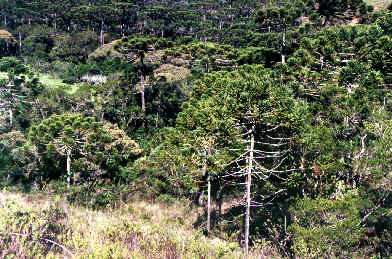
An Araucaria
Forest in Southeast Brazil.
Home to the rare Vinaceous-breasted Parrot,
and the specialized Araucaria Tit-Spinetail.
(Photo by Herb Cutler during Oct 2001 FONT
tour.)
We saw several species of
birds with affinities to particular trees. An odd-looking tree, native to
southeastern Brazil is the Araucaria. In it, we saw the endangered Vinacous-breasted
Parrot, as well as the Araucaria Tit-Spinetail.
In palm trees, along a river, in the Amazonian basin, we saw the Point-tailed
Palmcreeper - restricted to palms as much as the tit-spinetail is to
araucarias.
The palmcreeper we saw in palms. Woodcreepers on the trunks of trees.
And the streamcreeper we saw well, yes, along a stream - acting much as
it does like a waterthrush in the Northern Hemisphere.
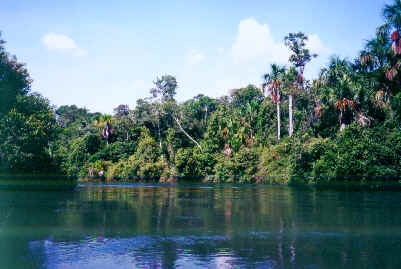
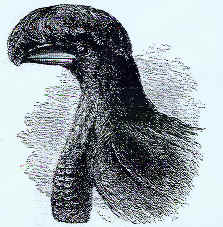
The
Rio Claro, in central Mato Grosso.
It was along this river that we saw a perched Amazonian
Umbrellabird,
the Point-tailed Palmcreeper in the palms,
and where at dusk potoos with open mouths were seen catching insects.
Other memorable moments during
the tour included:
In forests: a nice look at a Red-headed Manakin, encounters with Pheasant
Cuckoo and Pavonine Quetzal, and a flock of colorful Paradise
Tanagers.
Overhead, during the tour, we saw soaring King Vulture, and a procession of Swallow-tailed Kites. Perched we saw a wonderful Mantled Hawk, and a group of Greater Yellow-headed Vultures.
We enjoyed sightings of common Dusky-legged Guans, and the rare Black-fronted Piping-Guan.
We met up with migratory flocks - of Fork-tailed Flycatchers enroute to their breeding grounds further south, and a large mass, one afternoon, of thousands of Cliff Swallows that bred in North America.
On a dirt road, we saw a Greater
Rhea with about a dozen young. The large male and the little ones were
crossing in front of us.
On another dirt road, not crossing, but rather running in spurts ahead of us
for about a mile, was a Red-legged Seriema. That bird normally prefers
an open habitat. We saw it, though, along a forest road, and maybe as it
viewed the road ahead as "open", it continued to run ahead until
there was a junction where it went to the left and we went to the right.
We enjoyed our birding
throughout the tour. One of the last places we visited was a plantation at the
forest edge, filled with fruit - food for motmots, nunbirds, aracaris
and toucans, thrushes and tanagers.
In all, during our 10-day October 2001 tour, we tallied nearly 400 species of
birds.
All of the places we visited were great, but one in particular deserves a
special mentioning - a place now visited during 5 FONT Brazilian Tours. The
place known as the "Jardin da Amazonia", or the "Garden
of the Amazon", in the north-central region of Mato Grosso State.